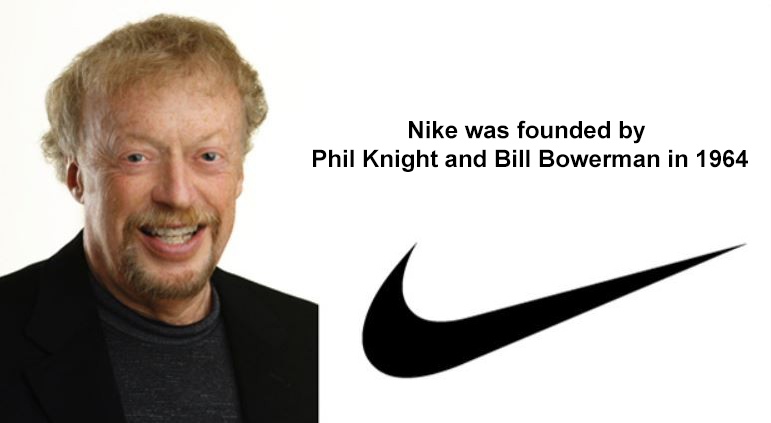The founder of Nike is Phil Knight, along with his coach Bill Bowerman. Here’s a brief history of the company and its origins:
Early History
- Phil Knight’s Background: Phil Knight, a middle-distance runner at the University of Oregon, was coached by Bill Bowerman. After graduating, Knight attended Stanford Graduate School of Business, where he wrote a paper suggesting that American shoe companies could compete with established German brands by using cheaper Japanese labor. This idea became the foundation for his future business endeavors.
- Blue Ribbon Sports: In 1964, Knight and Bowerman partnered to form Blue Ribbon Sports (BRS). Knight secured a deal with the Japanese company Onitsuka Tiger (now ASICS) to distribute their running shoes in the United States. Knight began selling these shoes from the trunk of his car at track meets and through mail order.
- Bill Bowerman’s Innovation: Bowerman was also experimenting with ways to improve athletic footwear. He famously used a waffle iron to create a new sole pattern for shoes, leading to the development of the “waffle” sole, which provided better traction and cushioning. This innovation became one of Nike’s first major product advancements.
The Birth of Nike
- Transition to Nike: By the early 1970s, the relationship between Blue Ribbon Sports and Onitsuka Tiger began to deteriorate. In 1971, BRS decided to launch its own line of footwear. The new brand was named “Nike,” after the Greek goddess of victory. The iconic “Swoosh” logo was designed by a graphic design student named Carolyn Davidson for just $35.
- Launch of Nike Shoes: The first line of Nike shoes hit the market in 1972, just in time for the U.S. Track and Field Trials. Bowerman’s innovative waffle-soled shoes were part of this initial launch, and they quickly gained popularity among athletes.
Growth and Expansion
- Marketing and Endorsements: Nike’s growth in the late 1970’s and early 1980’s was driven by a combination of innovative products and strong marketing campaigns. In 1978, the company officially changed its name from Blue Ribbon Sports to Nike, Inc. The brand’s “Just Do It” campaign, launched in 1988, became one of the most successful advertising slogans in history.
- Michael Jordan and Air Jordan: A significant turning point for Nike came in 1984 when the company signed a young basketball player named Michael Jordan to an endorsement deal. The Air Jordan line of basketball shoes, launched in 1985, revolutionised sports marketing and helped establish Nike as a dominant force in the athletic footwear industry.
Modern Era
- Diversification and Innovation: Over the years, Nike has expanded its product line to include apparel, equipment, and accessories for a wide range of sports and activities. The company has also embraced technological advancements, such as the Nike Air cushioning system, Nike Flyknit technology, and digital fitness tools like the Nike+ app.
- Global Brand: Today, Nike is one of the world’s leading sportswear brands, with a significant global presence. The company continues to innovate in both product development and marketing, staying at the forefront of the athletic apparel and footwear industry.
Phil Knight stepped down as CEO in 2004 but remained involved with the company as chairman until he officially retired from the board in 2016. He remains one of the most influential figures in the history of sports business. His memoir, Shoe Dog, provides an in-depth look at the early days of Nike and his journey as an entrepreneur.
FAQ’s
Here are some frequently asked questions (FAQs) about Nike and its history:
1. Who founded Nike?
Nike was founded by Phil Knight and Bill Bowerman in 1964. Initially, it was known as Blue Ribbon Sports.
2. When was Nike established?
Nike was officially established on January 25, 1964, as Blue Ribbon Sports. The company changed its name to Nike, Inc. in 1978.
3. Why is it called Nike?
The company was named after Nike, the Greek goddess of victory. The name was chosen to reflect the company’s focus on athletic success and inspiration.
4. Who designed the Nike logo?
The Nike “Swoosh” logo was designed by Carolyn Davidson, a graphic design student at Portland State University, in 1971. She was paid $35 for her work.
5. What is Nike’s mission statement?
Nike’s mission statement is: “To bring inspiration and innovation to every athlete* in the world.” (*If you have a body, you are an athlete.)
6. What is the significance of the waffle sole?
The waffle sole was an innovative design created by Nike co-founder Bill Bowerman using a waffle iron. This sole design provided better traction and cushioning, significantly improving running shoe performance. It played a crucial role in Nike’s early success.
7. When did Nike launch the Air Jordan line?
Nike launched the Air Jordan line in 1985 after signing a landmark endorsement deal with basketball player Michael Jordan in 1984. The Air Jordan shoes became hugely popular and are considered a significant part of Nike’s brand identity.
8. What is the “Just Do It” campaign?
“Just Do It” is one of Nike’s most famous advertising campaigns, launched in 1988. The slogan has become synonymous with Nike’s brand ethos, encouraging athletes to push their limits and persevere.
9. How has Nike contributed to sustainability?
Nike has implemented several sustainability initiatives, including using recycled materials in its products, reducing carbon emissions, and promoting fair labour practices. The company has introduced programs like “Move to Zero,” which aims for zero carbon and zero waste, and the Nike Grind program, which repurposed manufacturing waste and recycled shoes into materials for new products.
10. Where is Nike headquartered?
Nike’s global headquarters is located in Beaverton, Oregon, USA.
11. What are some of Nike’s key product innovations?
Nike has introduced several innovative products over the years, including:
- Nike Air: A cushioning technology introduced in 1979.
- Nike Flyknit: A lightweight, form-fitting, and environmentally sustainable shoe material introduced in 2012.
- Nike React: A foam technology providing a softer and more responsive cushioning experience.
- Nike Dri-FIT: A moisture-wicking fabric technology used in athletic apparel.
12. What sports does Nike cater to?
Nike designs and manufactures products for a wide range of sports, including running, basketball, soccer, golf, tennis, training, skateboarding, and more.
13. Who are some famous athletes endorsed by Nike?
Nike has endorsements with numerous high-profile athletes, including Michael Jordan, LeBron James, Serena Williams, Cristiano Ronaldo, Tiger Woods, and Naomi Osaka, among others.
14. What are some controversies Nike has faced?
Nike has faced several controversies over the years, including issues related to labour practices in overseas factories, environmental concerns, and the use of controversial advertising campaigns. The company has taken steps to address these issues through various corporate social responsibility initiatives.
15. How does Nike contribute to community engagement?
Nike engages with communities through various initiatives, including youth sports programs, grants, partnerships with non-profit organisations, and campaigns focused on diversity and inclusion. The Nike Community Impact Fund is one such program that supports local communities.
These FAQs provide a snapshot of Nike’s history, values, and impact in the sportswear industry.



